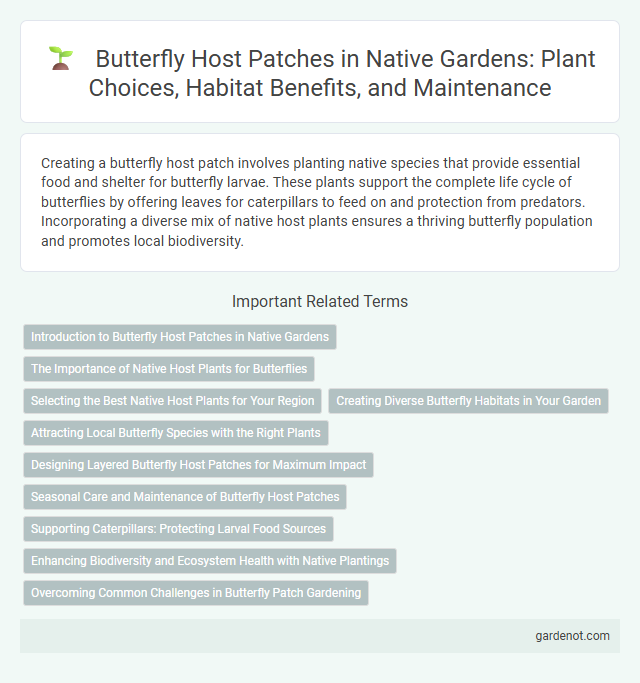Creating a butterfly host patch involves planting native species that provide essential food and shelter for butterfly larvae. These plants support the complete life cycle of butterflies by offering leaves for caterpillars to feed on and protection from predators. Incorporating a diverse mix of native host plants ensures a thriving butterfly population and promotes local biodiversity.
Introduction to Butterfly Host Patches in Native Gardens
Butterfly host patches in native gardens provide essential habitats where specific native plants serve as food sources for butterfly larvae, supporting their entire life cycle. These patches increase biodiversity by attracting a variety of butterfly species, promoting pollination and ecosystem health. Selecting regionally appropriate host plants like milkweed for monarchs or spicebush for swallowtails enhances butterfly survival and garden sustainability.
The Importance of Native Host Plants for Butterflies
Native host plants play a crucial role in supporting butterfly populations by providing essential food sources for caterpillars during their larval stage. Specialized relationships between butterfly species and native plants ensure higher survival rates and promote biodiversity within local ecosystems. Incorporating a diverse array of indigenous host plants into butterfly host patches enhances habitat quality and fosters sustainable pollinator communities.
Selecting the Best Native Host Plants for Your Region
Selecting the best native host plants for your region is essential to support local butterfly species and enhance biodiversity. Researching native plant nurseries and consulting regional plant guides ensures that you choose species adapted to local soil, climate, and butterfly preferences. Establishing a native butterfly host patch with plants such as milkweed, violet, or wild cherry improves caterpillar survival rates and encourages pollination within your ecosystem.
Creating Diverse Butterfly Habitats in Your Garden
Creating diverse butterfly habitats in your garden involves planting a variety of native host plants such as milkweed, passionflower, and violets, which support different butterfly species throughout their life cycles. Incorporating nectar-rich native flowers like coneflowers and black-eyed Susans provides essential food sources for adult butterflies, enhancing habitat quality and promoting pollinator health. Strategically positioning host and nectar plants in sunny, sheltered areas encourages butterfly activity and increases garden biodiversity.
Attracting Local Butterfly Species with the Right Plants
Selecting native butterfly host plants such as milkweed, violets, and parsley supports the life cycle of local butterfly species by providing essential food and breeding habitats. Incorporating these plants into a butterfly host patch encourages caterpillar development and increases butterfly populations in the area. Properly designed native plantings enhance biodiversity and promote ecological balance within native gardens and natural landscapes.
Designing Layered Butterfly Host Patches for Maximum Impact
Designing layered butterfly host patches involves selecting native plants that provide diverse foliage and nectar sources to support various butterfly species throughout their life cycles. Incorporate host plants such as milkweed, parsley, and violets in staggered heights and bloom times to create continuous habitat and food availability. Strategic layering maximizes habitat complexity, encouraging higher butterfly diversity and sustained population health.
Seasonal Care and Maintenance of Butterfly Host Patches
Seasonal care of butterfly host patches involves regular monitoring and pruning to encourage healthy growth and prevent overgrowth of invasive species. Mulching in early spring retains soil moisture and suppresses weeds, while late fall involves cleaning up debris to reduce disease and prepare plants for dormancy. Consistent seasonal maintenance supports the lifecycle of butterfly larvae and ensures the long-term vitality of native host plants.
Supporting Caterpillars: Protecting Larval Food Sources
Butterfly host patches play a critical role in supporting caterpillars by providing essential larval food sources such as milkweed for monarchs and willow for viceroys. These native planting areas help maintain biodiversity and promote healthy butterfly populations by ensuring caterpillars have access to the specific plants they need for growth and development. Protecting and cultivating these host plants in gardens and natural spaces directly supports the survival of early butterfly life stages and overall ecosystem balance.
Enhancing Biodiversity and Ecosystem Health with Native Plantings
Planting native butterfly host plants fosters biodiversity by providing essential habitats and food sources for native butterfly species, supporting their life cycles and promoting ecological balance. These native host patches improve ecosystem health by attracting pollinators, which contribute to plant reproduction and increase overall floral diversity. Integrating native plants in butterfly habitats strengthens local ecosystems, aiding soil health, water retention, and resilience to environmental stressors.
Overcoming Common Challenges in Butterfly Patch Gardening
Butterfly host patches often face challenges such as pest infestations, inadequate host plants, and poor soil conditions that hinder caterpillar survival and growth. Selecting native plant species like milkweed and passionflower tailored to local butterfly populations enhances larval food availability and resilience. Implementing organic pest control methods and improving soil health with compost supports sustainable butterfly patch gardening and promotes thriving butterfly populations.
Butterfly host patch Infographic

 gardenot.com
gardenot.com